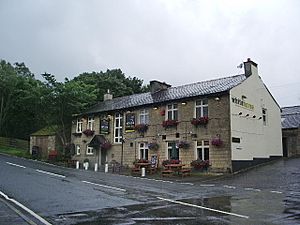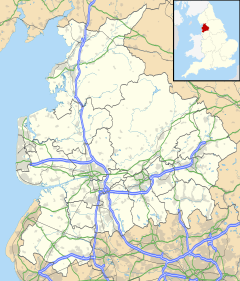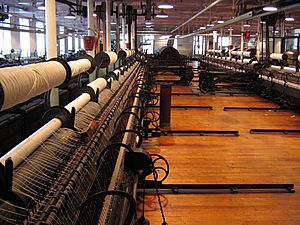Helmshore facts for kids
Quick facts for kids Helmshore |
|
|---|---|
 The former White Horse public house (now private housing) |
|
| Population | 5,805 (2011.Ward) |
| OS grid reference | SD782212 |
| District | |
| Shire county | |
| Region | |
| Country | England |
| Sovereign state | United Kingdom |
| Post town | ROSSENDALE |
| Postcode district | BB4 |
| Dialling code | 01706 |
| Police | Lancashire |
| Fire | Lancashire |
| Ambulance | North West |
| EU Parliament | North West England |
| UK Parliament |
|
Helmshore is a village in the Rossendale Valley, Lancashire, England. It is located south of Haslingden, between the A56 and the B6235 roads. Helmshore is about 16 miles north of Manchester. In 2011, about 5,805 people lived here. The houses in Helmshore are a mix of older terraced homes and newer housing estates built since the 1970s.
Contents
Helmshore's Past
Ancient Times
The land around Helmshore is mostly moorland. After the last Ice Age, this area was covered in forests. You can still find ancient bog oak on the flat peatlands, which are over 250 metres high. The forests started to shrink during the Neolithic period (New Stone Age) and mostly disappeared in the Bronze Age. This happened mainly because the climate changed, but also because people started to use the land more.
There is some proof that people lived here during the Neolithic period. Stone tools have been found on Bull Hill and in the Musbury valley. There are also old stones at Thirteen Stone Hill near Haslingden Grane. A network of old paths, both local and long-distance, crossed this area.
The Medieval Park
The village is overlooked by a flat-topped hill called Musbury Tor. This area was once a medieval hunting park or "Forest." On either side of the Tor are two valleys: Alden Valley to the south-west and Musbury Valley to the north-west.
The land of Musbury was given to John de Lacy before 1241. In 1294, the Earl of Lincoln was allowed to have a "free warren," which meant he could hunt certain animals there. Fencing for the park was finished by 1304–05. Even today, you can still see parts of the old ditch that enclosed the park in the Grane and Alden valleys. Deer are still sometimes seen in the area. Several local place names still remind us of this old park.
Old Travel Routes
One important old path that went through Helmshore was a route from the south. This path passed by the Pilgrim's Cross, which existed in 1176, on Holcombe Moor. It then went through Haslingden on its way to Whalley. This route also connected to Watling Street at Affetside. It was a well-known way to travel from Bolton to Rossendale.
In Anglo-Saxon times, Whalley church was a very important church for a huge area. Later, in the medieval period, smaller chapels were built closer to people so they could easily go to church. When monks moved to Whalley in the late 1200s, more people would have used this route. Some historians now think these "pilgrim routes" might have been used by drovers. Drovers were people who moved livestock, like cows and sheep, from grazing areas to markets.
South of Helmshore, on the old pilgrim road, is Robin Hood's Well. Above that is a pile of stones and a memorial stone for Ellen Strange. People used to believe she was a young girl murdered by her lover. However, it is now known that she was a wife murdered by her husband in 1761. The story became more colorful and fictional over time. These old routes were mostly used only by people walking after new turnpike roads were built in the 1800s.
The Industrial Revolution
Helmshore grew a lot because of its damp climate. This climate was perfect for making wool, cotton, and linen products. In the early days of the Industrial Revolution, starting in the 1790s, small mills were built in the river valleys. You can still see ruins of these mills in places like Alden Valley. Many mill owners were also farmers back then.
By the late 1800s, these small mills were replaced by much larger ones. Families like the Turners built many terraced houses for the workers needed to run their cotton mills. These new mills were built close to roads and railways. During this time, the name Helmshore slowly became more common than Musbury for the community.
Helmshore became a village known for its mills. It had many wool and cotton mills and houses for the workers. These were built along the valley of the River Ogden. The Turner family started this development. They bought land in 1789 and built Higher Mill. This was a woollen fulling mill, which used water wheels to power its machines. One of these water wheels still exists today and is part of the museum.
Later, William Turner (1793-1852) added a bigger mill for carding and spinning wool in the 1820s. This mill used steam power, and its chimney is still standing on the opposite hillside. After a fire in the 1860s, the mill was rebuilt. The Turners also built Tan Pits, a dye works, and the seven-story Hollin Bank (or Middle Mill) for power looms.
The area grew even more when the railway opened in 1848. New buildings included the Station Hotel and St Thomas's Church (built in 1851-1852). William John Porritt (1820-1896) was another important mill owner. He started as a hand-loom weaver and became a cotton merchant. The Porritts were known as good employers. Porritt invested a lot in the new seaside town of St. Annes. Some houses there were built with stone from his Helmshore quarries. He even sent his workers to see the opening of St. Anne's Pier by organizing special trains from Helmshore Station.
Porritt mills included the water-powered Bridge End Mill and the huge Sunnybank Mill. Sunnybank Mill was once said to have the longest loom in the world! Their mills were famous for making industrial felts, some of which were used to make bank notes. In 1922, Porritt gave the Memorial Gardens with its clock-tower to the village.
The Holden Wood Manufacturing Company, also known as the Bleach Works, was located north of the village. During World War II, it secretly produced a special fuel for aircraft. It closed in 1997. At that time, it made cellulose paper, some of which was used for bank notes. The factory caused some pollution in the River Ogden. However, an area at the eastern end of the works, called The Flash, was a wetland where Little Ringed Plover birds used to breed.
1860 Train Accident
| Helmshore rail accident | |
|---|---|
| Details | |
| Date | 4 September 1860 |
| Location | Helmshore, Lancashire |
| Country | England |
| Line | Lancashire and Yorkshire Railway |
| Cause | split train |
| Statistics | |
| Trains | 2 |
| Deaths | 11 |
| Injured | 77 |
| List of UK rail accidents by year | |
A serious train accident happened in Helmshore in September 1860. Eleven people died, and 77 were injured. The accident took place on the railway line between Snig Hole and the Ogden Viaduct, about 400 yards from Helmshore station. About 3,000 people had traveled from East Lancashire on three special trains to Salford. They were going to visit the attractions at Belle Vue Gardens.
The second train, carrying about 1,000 passengers in 31 carriages, stopped at Helmshore Station to let some people off. When the guard released the brakes, there was a sudden jerk. Sixteen carriages broke away from the train and started sliding down the tracks towards Ramsbottom. The superintendent saw what happened and quickly unhooked the engine from the train. He tried to go down the other track to warn the third train, but it was too late. The runaway carriages had already traveled 400 yards down the line and crashed into the oncoming third train.
Early Bus Service
Helmshore was part of one of the world's first public bus services! In 1907, a bus service connected Helmshore to Haslingden. The 18-seat Leyland bus was run by Haslingden Council. It made 14 trips a day and could go up to 16 miles per hour. In 1919, the Council added a 12-seater "Whippet" bus. The driver of this bus also sold tickets, making it one of the world's first bus services operated by just one person.
World War I
On September 25, 1916, a large German military Zeppelin airship flew over Helmshore. It was on a bombing mission, likely following the railway to try and damage the transport system. One bomb fell near Clod Lane, Haslingden, where there was a gun cotton factory. Ewood Bridge station was destroyed by bombs. After passing over Helmshore, the Zeppelin flew on to Holcombe and caused more damage there.
World War II
During World War II, Rodwells was Britain's biggest supplier of poultry. They had a large poultry farm between Irongate and Kenyon Clough, south of Helmshore. While it might seem small by today's standards, large-scale poultry farming only became common in the UK in the 1960s.
The West Pennine Way guide mentions that American soldiers (GIs) set up camp on the flat top of Musbury Tor. They practiced parachute drops and field exercises with live ammunition before D-Day. A local historian, Chris Aspin, also wrote about American paratroopers landing on Bull Hill in the autumn of 1941. He remembered seeing GIs camped near Great House just before D-Day and practicing with live ammunition in Alden Valley.
Old Railway Line
The railway line that ran through Helmshore closed in 1966. However, parts of the old railway still remain in and around the village. The Helmshore viaduct, which is near the textile museum, is now a footpath. The Ravenshore viaduct has been damaged but is still a big reminder of the railway's history. In 2018-2019, repair work was done on these viaducts for a cycle route called 'The Scenic Route Branch Line'. This route is part of the National Cycle Network Route 6. It connects Accrington through Rossendale, via Haslingden and Helmshore, to Ramsbottom. As part of this work, the Snig Hole/Ravenshore footpath was also improved.
Recent Developments
Since the 1970s, Helmshore has grown significantly again. Many new housing estates have been built, often for people who travel to Manchester for work.
Culture
Music
In 2001, an American music group called The Factory Incident released an EP (a short album) titled Helmshore. Karl Hill, one of the guitarists, named it to honor his late mother, Joyce Bargh Hill. She was born in Haslingden and grew up in Helmshore.
Helmshore Mills Textile Museum
The Helmshore Mills Textile Museum was originally called Higher Mill. It is a water-powered fulling mill and a 19th-century cotton spinning mill. It has working machinery that you can see. The Turners built it in 1789. Later, in the 1960s, Derek Pilkington and Chris Aspin saved it from falling apart.
Today, the museum is managed by Lancashire County Council Museums Service. It shows how textile technology has changed over the last three hundred years using interactive displays. The museum also includes mill ponds, weirs, sluice gates, and an aqueduct. You can see a working 19th-century waterwheel, fulling stocks, and other machines used to finish woollen cloth. It also has an original Arkwright water frame and a Hargreaves Spinning Jenny. There is also a museum shop that sells books about local textile history.
In 1856, Joseph Porritt started Sunnybank Mill, a huge mill that once had the world's largest spinning machines. The Whittakers were another important mill family in Helmshore, and one of their mills is now part of the Textile Museum.
The Tor Mile Race
Every year, an athletics race called The Musbury Tor Mile takes place in Helmshore. The race was first run in 1911, but it might be even older. Originally, runners ran to and around a large stone called Big Nor at the top of Musbury Tor, and then back. However, the race stopped for a while because the farmer no longer allowed people to use his land. The route was changed to make everyone happy. Now, the race is actually two kilometers long, which is about 1.2 miles. Since 2004, the race has been happening again and is part of the fell running tradition in the area.
Gallery
See also
- Listed buildings in Haslingden










